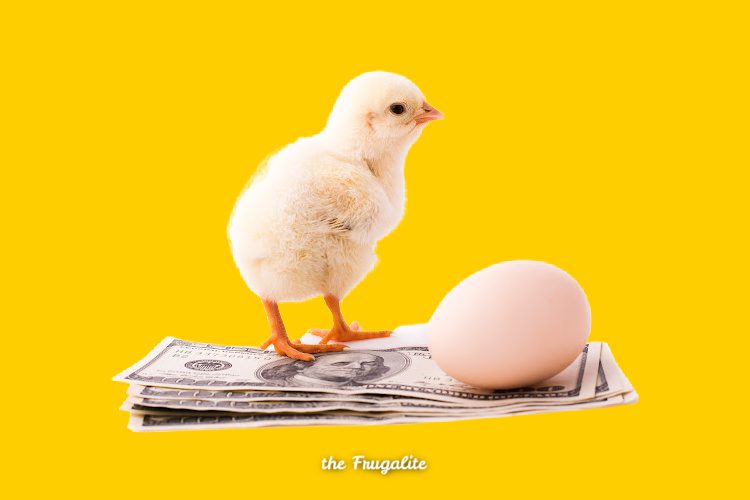(Psst: The FTC wants me to remind you that this website contains affiliate links. That means if you make a purchase from a link you click on, I might receive a small commission. This does not increase the price you’ll pay for that item nor does it decrease the awesomeness of the item. ~ Daisy)
Have you ever wondered if raising chickens could help you to cut back on your grocery bill? Is saving money with chickens just a myth?
I’ve raised chickens for five years now, keeping a pretty complete record of the cost-benefit analysis of owning these little feathered boogers. I believe I can make the case that owning chickens is economically a good decision.
So if you’ve been on the fence about whether raising chickens will save you money or not, read on. I think you’ll come to the same conclusions that I have.
How much do I need to get started?
The most expensive part about owning chickens is the startup cost because of the coop and the run. I’ve found that coops quickly become a major money pit, should you let them. If you’re looking to be as frugal as possible here, choose sheet metal. Using plywood is expensive, and you’ll likely have to invest in paint afterward as well. With sheet metal, you can make a respectable-looking coop with minimal investment. Here’s how Daisy used an old swingset as the basis of her coop.
Another option I would urge you to consider – should you have the land – would be to build a chicken tractor. This is a portable coop that you can easily move to fresh grass daily. These are very inexpensive to build, will keep your chickens on fresh grass daily, and make for happier chickens than a traditional coop does. You will also have higher quality eggs, cut down on your feed costs, and perform minimal cleaning.
For ideas on coops, I highly recommend Pinterest. There is all manner of coops present there, and you’re bound to leave with some great coop ideas. I have two options available on my farm: a coop and a chicken tractor.
- The coop cost me roughly $350 to build, including sheet metal, lumber, metal screws, and concrete.
- The chicken tractor cost me $100.
Coops are pretty straightforward. The two caveats I’ll add about chicken tractors are these: build them resistant to chicken thieves (use small hole chicken wire), and make them as light as you can. I lost many birds to raccoons about a year ago in my tractor before I caught on to what was happening.
I’d opened a chicken dinner drive-through for coons and didn’t even know it.
The reason to make your tractors as light as possible is so your daily chores are as easy as possible. Building a 200-pound chicken tractor doesn’t help you to do that.
Which chicken should I choose?
I’ve raised White Leghorns, Easter Eggers, Rhode Island Reds, Buff Brahmas, and a host of other different breeds of chickens. Without hesitation, I can say that if it’s egg production you’re looking for, you want to buy Black Australorps. Last I heard, it was Black Australorps that still had the world record for yearly egg production, and I can attest that these birds are daily layers.
And that’s exactly what you want.
If you’re raising a flock of birds that are only laying an egg every 2-3 days, you’re spending money on inefficient layers. You’ll get much more food for your money if you choose an efficient layer.
To further illustrate, let’s say I have a flock of 6 chickens. If all those birds are Easter Eggers, I’ll get in the ballpark of 18 eggs/week. If all those birds are Black Australorps, I’ll typically get around 42 eggs/week. And that’s for exactly the same feed cost. Should you not eat 42 eggs/week, you can easily sell a few dozen eggs for $3/dozen, if not more. Making $6/week for your eggs in addition to getting to eat 18 eggs yourself is not a bad deal for a minimal investment.
Wondering how to raise your baby chicks on a budget? Check out this article.
What kind of meat bird do you recommend?
If you’re looking at raising birds specifically for meat, I believe that Cornish Cross is the only way to go. While these are a Franken-bird, no other bird out there can gain as much weight as quickly as these can. If you’re looking for the most cost-effective means of putting chicken on the table, these birds are it.
You’ll have to buy them as chicks for around $3/chick, and I slaughter mine at week 8. These are hearty eaters, requiring more feed than a regular chicken, but by the time you slaughter them, you’ll appreciate the extra meat a Cornish Cross gives you.
These are they type of bird your local grocery store stocks, and a single bird can easily feed you for a week.
Culling the flock
A pet is a money drain. You cannot let your chickens become pets if you are raising them with the economy in mind. All chickens lose productive value after two years of age. Put simply, younger chickens lay more eggs.
For this reason, you need to let your chickens live for two years, and then you need to cull the older hens. This will benefit your cost-to-egg ratio and will also put meat on your table. To be as economical as possible with eating your birds, I recommend simply chopping off the head with a hatchet and then skinning the carcass.
You can spend money on killing cones, scalding tanks, plucking machines, and the like. However, they are all expensive pieces of material you don’t need for harvesting the occasional bird. If you’re looking at jumping into raising large quantities of meat birds for your family regularly, then, by all means, buy the time-saving equipment.
Otherwise, I believe it’s a waste of resources.
No Roosters!
To be as economical as possible, you need to avoid roosters. Should you purchase chicks and later discover you have roosters, butcher them when they’re big enough to eat. For the typical chicken raiser (chicken tender?), roosters are a waste of resources. They’re another mouth to feed, only this time, the mouth isn’t giving you any eggs in return.
If you want to raise your own chicks in the future from your flock, then yes, you’ll need a rooster. That’s the only reason I would consider raising nature’s alarm clock, though.
What are the maintenance costs of raising chickens?
The only maintenance costs I have are:
- Occasionally patching up the chicken wire
- Replacing black plastic netting over the run
- Purchasing straw.
Chicken wire and black plastic netting last me several years, so this isn’t a huge issue. The predominant thing you’re going to have to keep tabs on is adding carbon to the coop to cut down the smell, improve coop hygiene, and make for healthier chickens.
You can save money here by using pine needles, leaves, or grass clippings from your yard as often as possible here. Neighbors may be more than happy to let you have their leaf piles in the fall as well. If you can’t get access to any of these, you’re going to need to buy straw.
Typically, I can get by with a bale of straw per month before I need to add more to my coop. That’s about how long it lasts in my next boxes and about how long until I notice the coop and run require attention. This will depend on how many chickens you have and the size of your run/coop, but at the moment, straw costs $5/bale.
So from a maintenance perspective, I would say you could look at spending $60/year for carbon.
What does it cost to feed chickens?
Feed is going to be your main cost with raising chickens. Unfortunately, there’s a global soybean shortage at the moment, and seeing that this is one of the primary ingredients in chicken feed, layer pellets are currently at a high price.
Within my region, $15 for 50 pounds of feed is the norm at the moment. You can get better deals if you shop around or find a local feed mill, but $15 is pretty standard. I have a flock of approximately 12 birds, and I currently go through a bag every ten days or so. (Update: chicken feed here now costs $17 per 50-pound bag, a $2 increase within the span of four months.)
You can cut down on this feed cost by keeping a bucket on your kitchen counter to collect kitchen scraps for your birds. You can also allow your birds free-range throughout your property all day. Either way though, spending $15 every ten days to get 100 eggs isn’t a bad tradeoff.
Final thoughts on raising chickens
As far as livestock goes, chickens are easily one of the easiest animals to raise. They’re mischievous as all get-out, finding unimaginable ways out of their coop so they can poop on your front porch. But they give you a lot of benefits with minimal investment. I highly recommend anybody with the ability to do so to invest time and money into chickens. The birds will easily pay for themselves with time, you’ll get a healthier product than what the store offers, and you’ll have a lot of fun doing so in the process.
What are your thoughts? Do you raise chickens? Do you have additional tips for raising birds as frugally as possible? Let us know in the comments below!












6 thoughts on “Will Raising Chickens Save You Money?”
Don’t forget that if you have a garden, or fruit trees/shrubs, your chickens are also providing you with excellent fertilizer (does need composting, of course, although you can scatter some directly around your fruit trees in the fall with no ill effects).
Lawn clippings (chemical free, of course) can be fully dried and stored, or even fermented to silage in black plastic bags, for your chickens to enjoy when there’s no fresh grass. There have also been folks who collect a fresh road kill and slice it open for the chickens–they *are* natural scavengers, after all!
We have raised chicks for at least 25 years. Our chickens pay for themselves. But we have a lot. 25 to 40. From the money I receive from their eggs , 3 dollars a dozen currently, I am able to feed them, have money to purchase and raise the new layer chicks every year ( I retire them after 2 years) and most years purchase and raise the meat chickens from my profits. So excluding the work involved, and there is work involved, we receive free eggs and meat. It’s a win win for us. We live up here in NW Montana so we need sturdier coops with protection from the elements. But we don’t have a heat source for them. If you wish to have them lay through the winter you’ll need to provide a minimum of 12 hours of light a day. Led lights work well and use little electricity.
We have been raising chickens for many years. We gather 15-20 bags of fluffy fall leaves to use as litter in the chicken coop. Works great and is free.
We use a deep litter method so a bale of straw lasts about a year. Getting a rodent-proof feeder paid for itself by minimizing food waste. For culling, the broomstick method is fast and humane.
Good to know about the Australorps – we’ll look into those next.
At $3 per doz. eggs, subtract the cost of feed, then try & calculate how much per hour you pay yourself in labor to collect, wash & package (add at least 60 Cents per egg carton if you don’t get them free somehow, don’t add in the labor to buy them?).
Is it a Penny an hour in profit you’re making selling eggs?
When egg prices at the grocery store dropped, many people stopped buying $3 per doz. free range eggs, so there’s zero chance of getting more $ per doz. I read somewhere once, Do Not try & figure out how much it costs you in time & materials or you’ll get discouraged. Or, something to that effect. …Can you tell I stopped selling eggs?
Anyway, been using wood shavings as deep litter, seems it’s about the same cost as straw, and some people say straw isn’t the best to use ’cause mites hide in them. YMMV?
Good introductory article. …Now, about the labor costs of moving that chicken tractor daily… ha.
I’ve been raising chickens for about 10 years and decided to give excess eggs away as a part of my giving and tithing. I get extra greens for them from the dumpster behind the local grocery store. I don’t ask permission to avoid the “red tape”. A local wood worker gives me his wood shavings and I occasionally give him eggs. I also barter eggs for other foods. I built my coop to be rodent proof (resistant) from salvaged metal and lumber with a cement footer (the cement and entry door was the only out of pocket expense). I currently have about 50 chickens.